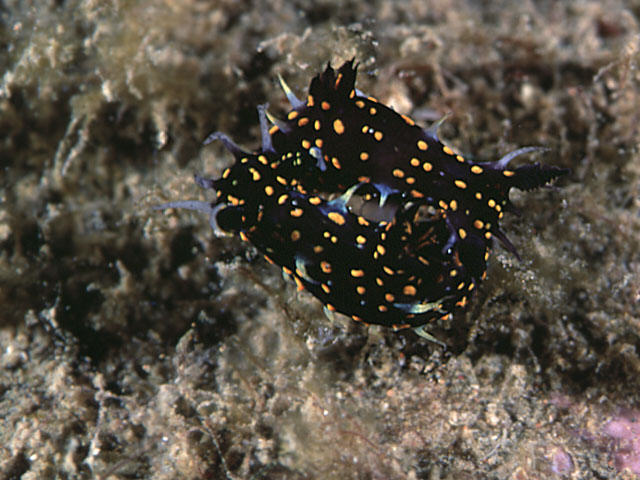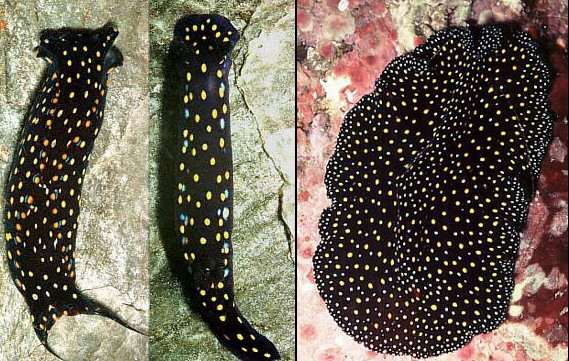 |
Polycera alabe
Photo courtesy of Erik Erikson, MetaVisual Inc.Catalina Island, June 1998
Polycera alabe Collier & Farmer, 1964
This species of Polyceratid dorid nudibranch was given the Greek name "alabe" in recognition of its black "ink" like color. Its long, slender phanerobranch shaped body is deep black in color with oval yellow-orange spots and elongate blue papillae. The geographic range is reported in Pacific Coast Nudibranchs and Sea of Cortez Marine Invertebrates as being throughout the Gulf of Mexico and Isla Cedros off the outer coast of Baja California. During the El Nino Summer of '98, the range was extended to as far north as, South Coronados Island (J. Allen, pers.comm.), La Jolla Canyon (G. Spalding & M. Miller, pers. comm.), Catalina, Anacapa and Santa Barbara Islands (Erik Erikson, Dan Richards and Kathy deWet, pers. comm).
An interesting topic of discussion and hypothesis concerns this species striking color similarity to two other co-occurring species of opisthobranchs and one flatworm within the Gulf of California. Gosliner and Behrens (1990) in our paper on Special Resemblance, Aposematic Coloration and Mimicry in Opishtobranchs reported the first example of Mullerian mimicry between opisthobranchs and another marine organism, this being Navanax inermis, Hypselodoris ghiselini and the polyclad flatworm, Pseudoceros bajae. More recently it has been suggested that one might add P. alabe to this group, depending upon your understanding of the two major types of mimicry.
For those of you who can't quite remember the difference between Mullerian mimicry and Batesian mimicry, it goes as follows: Mullerian mimicry is where two or more unpalatable species derive combined protection by resembling each other for the purpose of simplification of recognition by predators as unpalatable. A sort of shared protection by cooperative advertising campaign, concept. Each acts as both "model" and "mimic." Batesian mimicry, however, is when a palatable species (the "mimic") affords protection by resembling an unpalatable species (the "model"), one that is protected by some repellent qualities, such as acid secretions or other noxious chemicals. Dr. Bill Rudman's Sea Slug Forum contains a terrific discussion of some of the many examples of mimicry in Opisthobranchs.
While discussing this particular group of look-a-likes (based upon a couple of submissions from our webmaster) Bill asks if the quite variably colored Navanax co-occurs with H. ghiselini, and is Navanax mimicing the nasty tasting H. ghiselini? Terry Gosliner and I contend the relationship, mentioned above, is Mullerian because all three of the species do co-occur and "all" are unpalatable. Navanax secretes a noxious liquid from its yellow gland, Hypselodoris secretes acid from it mantle glands, toxicity in polyclad worms is suggested by many workers.
Whether the striking similarity in color between Polycera alabe, and these three sympatric species constitutes Mullerian or Batesian mimicry might be argued. To my knowledge, nobody eats, the beautiful, but slimy, Polycera alabe. Unlike the species discussed above it has no apparent protective mechanism to accomplish such protection. No palatability studies have been conducted to demonstrate this however. Until we can say for sure that P. alabe is in fact unpalatable to its potential predators, in my mind, this represents Batesian mimicry - P. alabe (the "mimic") benefiting from resembling the three nasty, unpalatable "model" species discussed above.
In the absence of any taste test volunteers, we will have to keep our eyes
open and see if we can document any evidence to support or refute this
hypothesis.
Danville, Calif
Apr. 2000
References:
Gosliner, Terrence M. and David W. Behrens. 1990. Special Resemblance,
Aposematic Coloration and Mimicry in Opishtobranch Gastropods. In Adaptive
Coloration in Invertebrates: Proceedings of a Symposium by the American
Society of Zoologists. M. Wicksten (Ed.) Texas A&M Univ. Sea Grant
Program. TAMU-SG-90-106.
Kerstitch, Alex . Sea of Cortez Marine Invertebrates, A Guide for the Pacific Coast, Mexico to Ecuador, Sea Challengers, Monterey, California 1989
Opisthobranchiata de Baja California Sur, Mexico. Thesis of Orso Juan Angulo Campillo. La Paz, B.C.S. Marzo de 2000

| Pictured from left to right are Navanax inermis, Hypselodoris ghiselini , and the flatworm Pseudoceros bajae. All three in addition to Polycera alabe with have been documented at Bahia de Los Angeles, Baja California at one time or another. We have seen three out of the four at Punta la Gringa during a four day dive trip there in conjunction with studies conducted by Dr. Hans Bertsch. Its conceivable that all four could be seen on one dive in this area! Drs. Angel Valdes and Hans Bertsch are currently working on the complex of similar color patterns of these species.
San Diego, CA Apr. 2000 |
Taxonomic information courtesy of Dave Behrens

David W. Behrens
Author:
Pacific Coast Nudibranchs
Send Dave mail at seachalleng@earthlink.net
|
